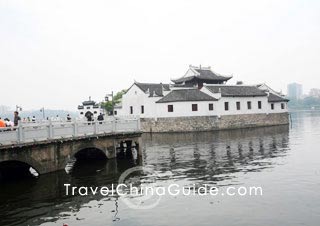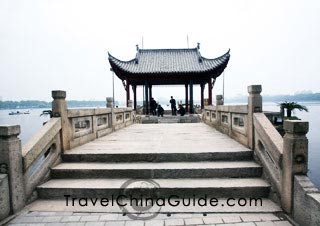Gantang Lake & Suojiang Tower
Gantang Lake
With an area of about 80 hectares (approximately 956,823 square yards), Gantang Lake is in the center of Jiujiang City. It is a natural lake, and the most attractive place of interest in the city.
Gantang Lake was once called Jingxing Lake. In the Tang Dynasty (618-907), Jingxing Lake was bisected by a dike that was built to facilitate the transportation at that time. The divided lakes are now separately called South Lake in the east of the dike and Gantang Lake in the west. In the lake's center stands Yanshui Pavilion (Smoky Water Pavilion) connected by a crooked bridge to the bank. The Yanshui Pavilion is a series of buildings connected by corridors. These ancient buildings in the pavilion are Chuangting Hall, Cuichaoxian Pavillion, Yanhui Pavillion, Wuxian Pavilion, etc.
 |  |
From the dike, you can climb Yingyue Pavilion (Moon Reflection Pavilion). With a bird's eye view from the pavilion, you can see the green water rippling in the gentle breezes, rosy clouds reflected in the water and willow trees lining the lakeshore. It is a beautiful scene.In the vicinity of Gantang Lake, there are many hotels with good facilities, such as Yuanzhou International Hotel, Education Hotel, Jiujiang Hotel, etc.
Lao'an fensi (vermicelli made from bean starch) soup is a very delicious local food with many ingredients and tastes.
| Admission Fee: | free |
| Transportation: | take bus No.16, 101, 102 or 103 to go there. |
Suojiang Tower
Located on the bank of the Yangtze River, in Jiujiang City, Suojiang Tower is the name given to a group of ancient buildings, including Suojiang Tower, Suojiang Pagoda (Wenfeng Pagoda), and four iron oxen guardians. When traveling by steamboat along the river, Suojiang Pagoda is the first thing you see as you enter the district of Jiujiang, and thus is regarded as the symbol of Jiujiang City.
The tower was firstly built in 1586 by an official of Jiujiang City, Wu Xiu, in the Wanli Reign of Ming Dynasty (1368-1644). It was built because the low-lying city of Jiujiang, surrounded on three sides by the Yangtze River, was vulnerable to flooding. It took eighteen years for the tower, which was paid for by collections of money, to be built. The tower has three stories and is surrounded by four iron oxen.
A pagoda was built at a later point near Suojiang Tower - Suojiang Pagoda, also known as Wenfeng Pagoda. Standing at a height of about 35 meters (about 115 feet), people can travel to the top of the Pagoda via a wooden staircase, where they can receive a view of Jiujiang City and Yangtze River. Suojiang Pagoda is built of stones and medieval thick bricks, making its seven stories very solid.
Suojiang Tower and Pagoda were built to protect people from disasters, but these structures don't seem to have the same power over themselves. The ravages of earthquakes and wars led to Suojiang Tower being almost completely destroyed. In the Second World War, Japanese invaders shelled Jiujiang City with cannons. Suojiang Pagoda was caught up in a bombardment. Because of the shelling, the Pagoda now slopes northeastward; the top of the Pagoda has already strayed away from the centerline by about 76 centimeters (2 feet). The fact the Pagoda is still standing is an attestation to the wonderful skills of the ancient workmen.
In 2004, the local government rebuilt and restored Suojiang Tower and Pagoda in order to preserve these fantastic examples of ancient architecture. Both are well worth a visit while you are in Jiujiang.
| Admission Fee: | CNY 20 |
| Transportation: | take bus No.5 or 23 to go there. |